Alerting Solutions, Inc.: Difference between revisions
(Add image from CDS) |
ArxCyberwolf (talk | contribs) (Added images.) |
||
| Line 2: | Line 2: | ||
{{Infobox manufacturer|title=Alerting Solutions, Incorporated|names=Raytek Technologies (formerly) | {{Infobox manufacturer|title=Alerting Solutions, Incorporated|names=Raytek Technologies (formerly) | ||
Alerting Solutions, Inc.|hq=Martinez, CA|founded=1979|defunct=2019|products=Outdoor warning sirens|image=ASI.png}} | Alerting Solutions, Inc.|hq=Martinez, CA|founded=1979|defunct=2019|products=Outdoor warning sirens|image=ASI.png|caption=ASI's logo in the late 2000s, after splitting from HÖRMANN.}} | ||
'''Alerting Solutions, Incorporated''' ('''ASI''') was a company based out of Martinez, CA. Originally existing as a HÖRMANN dealer under the name Raytek Technologies, Inc., the company became HÖRMANN America and later ASI, who created sirens very similar to the [[Acoustic Technology, Inc.|ATI HPSS]] and ASC [[ASC E-Class|E-Class]] in appearance. The company became a wholly owned subsidiary of AtHoc, Inc in 2013, acting as a dealer for ASC before ceasing operations entirely in 2019. | '''Alerting Solutions, Incorporated''' ('''ASI''') was a company based out of Martinez, CA. Originally existing as a HÖRMANN dealer under the name Raytek Technologies, Inc., the company became HÖRMANN America and later ASI, who created sirens very similar to the [[Acoustic Technology, Inc.|ATI HPSS]] and ASC [[ASC E-Class|E-Class]] in appearance. The company became a wholly owned subsidiary of AtHoc, Inc in 2013, acting as a dealer for ASC before ceasing operations entirely in 2019. | ||
== History == | == History == | ||
[[File:HA-416 Towable.jpg|left|thumb|393x393px|The ASI towable mobile speaker station. It is solar powered, with an extendable tower with an HA-416 siren on top.]] | |||
Alerting Solutions originally began as a different company based out of Santa Cruz, CA, under the name Raytek Technologies, Inc. in late 1979, who were a dealer for HÖRMANN in the United States. Alonside selling the electronic [[HÖRMANN ECX|ECL]] and mechanical [[E57]] sirens, Raytek also experimented with designs of their own by 1983, creating things such as a rotational electronic siren. Raytek existed under HÖRMANN for many years, and interest was garnered from other companies such as [[Sentry Siren]] to produce electronic sirens for them. This ultimately fell through by the early 1990s, however. Raytek became an official subsidiary of HÖRMANN America around this time. | Alerting Solutions originally began as a different company based out of Santa Cruz, CA, under the name Raytek Technologies, Inc. in late 1979, who were a dealer for HÖRMANN in the United States. Alonside selling the electronic [[HÖRMANN ECX|ECL]] and mechanical [[E57]] sirens, Raytek also experimented with designs of their own by 1983, creating things such as a rotational electronic siren. Raytek existed under HÖRMANN for many years, and interest was garnered from other companies such as [[Sentry Siren]] to produce electronic sirens for them. This ultimately fell through by the early 1990s, however. Raytek became an official subsidiary of HÖRMANN America around this time. | ||
| Line 14: | Line 15: | ||
== Products == | == Products == | ||
ASI's sirens universally use Kingstar TU330/Taixing Minsheng Electronic fiberglass speakers, each containing 4 100 W speaker compression drivers. ASI's sirens can be told apart from similar sirens through the way they are mounted, as ASI's sirens often lack a frame to attach to and instead rely on the customer to install them onto an existing pole, which leads to some very unique setups. ASI lacked a controller of their own, originally relying on HÖRMANN (ASC) or Federal Signal electronic siren controllers. ASI's sirens operated on 24 V DC as standard, equipped with batteries and/or an optional solar panel which allows the siren to run up to 30 minutes after grid power is lost. | ASI's sirens universally use [[Kingstar Sound Industry, Ltd.|Kingstar]] TU330/Taixing Minsheng Electronic fiberglass speakers, each containing 4 100 W speaker compression drivers. ASI's sirens can be told apart from similar sirens through the way they are mounted, as ASI's sirens often lack a frame to attach to and instead rely on the customer to install them onto an existing pole, which leads to some very unique setups. ASI lacked a controller of their own, originally relying on HÖRMANN (ASC) or [[:Category:Federal Signal Corporation|Federal Signal]] [[MCP]]/[[Federal Signal UltraVoice|UltraVoice]] electronic siren controllers. ASI's sirens operated on 24 V DC as standard, equipped with batteries and/or an optional solar panel which allows the siren to run up to 30 minutes after grid power is lost. | ||
=== Stationary Electronic Sirens === | === Stationary Electronic Sirens === | ||
[[File:ASI HA400SPKR.jpg|left|thumb|160x160px|A pair of ASI HA400SPKR units located at Los Medanos College in Pittsburg, CA. This photo was used on ASI's old website.]] | |||
==== HA400SPKR ==== | ==== HA400SPKR ==== | ||
Advertised as the "building block" of all of ASI's sirens, the HA400SPKR is little more than a Kingstar speaker shell with ASI's branding on the cone. These speakers were sold independently of ASI's other sirens, which could allow for additional speakers to be added to an existing speaker station without needing to buy an entire new siren if more output was required. The HA400SPKR contains 4 100 W speaker compression drivers of unknown manufacture, and can be mounted independently just about anywhere through the contained mounting bracket, which has a swivel which allows the speaker to be aimed vertically where needed. These sirens were advertised as being useful for campus use, mounted on rooftops or walls. These are similar in purpose and function to a [[Whelen HORNET|WS400H]], [[ASC i-FORCE|Quadren]], or [[Federal Signal DSA|DSA]] array. A single HA400SPKR unit can output up to 131 dB at point blank range. | Advertised as the "building block" of all of ASI's sirens, the HA400SPKR is little more than a Kingstar speaker shell with ASI's branding on the cone. These speakers were sold independently of ASI's other sirens, which could allow for additional speakers to be added to an existing speaker station without needing to buy an entire new siren if more output was required. The HA400SPKR contains 4 100 W speaker compression drivers of unknown manufacture, and can be mounted independently just about anywhere through the contained mounting bracket, which has a swivel which allows the speaker to be aimed vertically where needed. These sirens were advertised as being useful for campus use, mounted on rooftops or walls. These are similar in purpose and function to a [[Whelen HORNET|WS400H]], [[ASC i-FORCE|Quadren]], or [[Federal Signal DSA|DSA]] array. A single HA400SPKR unit can output up to 131 dB at point blank range. | ||
[[File:ASI HA-416.png|thumb|160x160px|An ASI HA-416, located in Port Costa, CA. It is a very rare example of an active ASI siren.]] | |||
==== HA-416 ==== | ==== HA-416 ==== | ||
The HA-416 is a directional 1600W electronic siren that is almost identical in appearance and function to an ATI HPSS-16 or E-Class EC8. The HA-416 consists of 4 HA400SPKR units attached to a common controller. The speakers do not come included with a frame, and instead this siren is designed to have the speakers mounted to an existing pole. Because of this, each HA-416 station is highly customizable, with either one speaker facing in each direction, or sacrificing output in one direction to boost output in another by having two speakers facing one direction. Each speaker contains 4 100 W speaker compression drivers for a total of 16 drivers, and the siren reaches 121 dB at 100 ft. A variant of the HA-416 exists called the HA-416D, which is a directional variant of the HA-416 which includes a rectangular metal mounting frame that allows multiple speakers to face one direction with ease. The HA-416D is otherwise entirely identical to an HA-416. Very few HA-416 units remain, with even fewer currently in service. | The HA-416 is a directional 1600W electronic siren that is almost identical in appearance and function to an ATI HPSS-16 or E-Class EC8. The HA-416 consists of 4 HA400SPKR units attached to a common controller. The speakers do not come included with a frame, and instead this siren is designed to have the speakers mounted to an existing pole. Because of this, each HA-416 station is highly customizable, with either one speaker facing in each direction, or sacrificing output in one direction to boost output in another by having two speakers facing one direction. Each speaker contains 4 100 W speaker compression drivers for a total of 16 drivers, and the siren reaches 121 dB at 100 ft. A variant of the HA-416 exists called the HA-416D, which is a directional variant of the HA-416 which includes a rectangular metal mounting frame that allows multiple speakers to face one direction with ease. The HA-416D is otherwise entirely identical to an HA-416. Very few HA-416 units remain, with even fewer currently in service. | ||
[[File:HA-624.png|left|thumb|160x160px|An ASI HA-624 in a bidirectional configuration, which was located in Pacifica, CA. It was replaced by a [[:Category:Federal Signal Corporation|FS]] [[Modulator]] after less than 3 years in service.]] | |||
==== HA-624 ==== | ==== HA-624 ==== | ||
The HA-624 is a rare omnidirectional 2400 W electronic siren that serves to bridge the gap between the HA-416 and HA-832. The HA-624 is a unique siren that makes use of 6 ASI HA400SPKR units attached to a common hexagonal frame, which could be mounted to the top of an existing pole. The frame is not required to mount the speakers, and as such the customer can choose a wide variety of configurations. One such installation was a bidirectional install with 3 speakers facing in each direction. The HA-624 has 6 speakers, each containing 4 100 W speaker compression drivers for a total of 24 drivers. The siren's decibel rating is unknown, and little else is known about this siren due to the fact that it is not listed on ASI's website, despite a picture of the siren being on the homepage. None of these sirens are known to survive. | The HA-624 is a rare omnidirectional 2400 W electronic siren that serves to bridge the gap between the HA-416 and HA-832. The HA-624 is a unique siren that makes use of 6 ASI HA400SPKR units attached to a common hexagonal frame, which could be mounted to the top of an existing pole. The frame is not required to mount the speakers, and as such the customer can choose a wide variety of configurations. One such installation was a bidirectional install with 3 speakers facing in each direction. The HA-624 has 6 speakers, each containing 4 100 W speaker compression drivers for a total of 24 drivers. The siren's decibel rating is unknown, and little else is known about this siren due to the fact that it is not listed on ASI's website, despite a picture of the siren being on the homepage. None of these sirens are known to survive. | ||
[[File:HA-832.png|thumb|214x214px|An ASI HA-832, which was part of Pacifica, CA's tsunami siren system. It was replaced by a Modulator II 8032B after less than 3 years of service.]] | |||
==== HA-832 ==== | ==== HA-832 ==== | ||
| Line 31: | Line 36: | ||
=== Rotational Electronic Sirens === | === Rotational Electronic Sirens === | ||
[[File:ES-200-R4.jpg|left|thumb|225x225px|The ES-200-R4 rotational siren, as advertised in 1983 by Raytek.]] | |||
==== ES-200-R4 ==== | ==== ES-200-R4 ==== | ||
The ES-200-R4 was a unique rotational electronic siren that was produced by Raytek Technologies around 1983. It was the first siren produced by the company itself, rather than an existing HÖRMANN design, and had a high decibel rating of 125 dB at 100 ft, outperforming the then-new [[Federal Signal EOWS|EOWS*812]] and [[Whelen WS-3000|WS-3000]]. The siren's design is reminiscent of the [[Whelen WS-2000|WS-2000R]], consisting of 4 HÖRMANN [[HÖRMANN HLS|HLS-381]] pneumatic siren horns with high power speaker compression drivers attached to the back of each horn, stacked vertically. Each horn is attached to the side of a cylindrical tube that contains the siren's wiring, leading to a small rounded box below the tube. The siren's presumably chain-driven rotator and collector rings are located in a teardrop-shaped housing below the siren. Unlike most rotational sirens, the ES-200-R4 is designed to be mounted to the side of a pole, rather than on top of one due to the rotator's unique shape. These sirens were purchased by a few nuclear power plants, but otherwise saw relatively few sales compared to its competition. It is unknown when this siren was discontinued, however it was likely when the company was reformed into HÖRMANN America. | The ES-200-R4 was a unique rotational electronic siren that was produced by Raytek Technologies around 1983. It was the first siren produced by the company itself, rather than an existing HÖRMANN design, and had a high decibel rating of 125 dB at 100 ft, outperforming the then-new [[Federal Signal EOWS|EOWS*812]] and [[Whelen WS-3000|WS-3000]]. The siren's design is reminiscent of the [[Whelen WS-2000|WS-2000R]], consisting of 4 HÖRMANN [[HÖRMANN HLS|HLS-381]] pneumatic siren horns with high power speaker compression drivers attached to the back of each horn, stacked vertically. Each horn is attached to the side of a cylindrical tube that contains the siren's wiring, leading to a small rounded box below the tube. The siren's presumably chain-driven rotator and collector rings are located in a teardrop-shaped housing below the siren. Unlike most rotational sirens, the ES-200-R4 is designed to be mounted to the side of a pole, rather than on top of one due to the rotator's unique shape. These sirens were purchased by a few nuclear power plants, but otherwise saw relatively few sales compared to its competition. It is unknown when this siren was discontinued, however it was likely when the company was reformed into HÖRMANN America. | ||
[[File:HA-416DR.png|thumb|216x216px|The HA-416DR as advertised on ASI's website. The picture is very likely not accurate to the real siren.]] | |||
==== HA-416DR ==== | ==== HA-416DR ==== | ||
The HA-416DR was a directional, rotational variant of the HA-416 that served as the replacement of the ES-200-R4. Like its predecessor, the HA-416DR consists of 4 speakers arranged vertically attached to a metal tube containing the wiring, spun by a rotator located underneath. The HA-416DR makes use of 4 HA400SPKR speakers, each containing 4 100 W speaker compression drivers for a total of 16 drivers. The siren was advertised as reaching 127 dB at 100 ft. The siren was rotated 360 degrees through a small rotator located underneath the siren, the design of which is unknown. Unfortunately, little else about this siren is known, as the only visual depiction of this siren from ASI is a photoshopped image. The lack of existing units, as well as the lack of photographic evidence of this siren's existence, suggests this siren never made it to production and only exists in ASI's catalogue. | The HA-416DR was a directional, rotational variant of the HA-416 that served as the replacement of the ES-200-R4. Like its predecessor, the HA-416DR consists of 4 speakers arranged vertically attached to a metal tube containing the wiring, spun by a rotator located underneath. The HA-416DR makes use of 4 HA400SPKR speakers, each containing 4 100 W speaker compression drivers for a total of 16 drivers. The siren was advertised as reaching 127 dB at 100 ft. The siren was rotated 360 degrees through a small rotator located underneath the siren, the design of which is unknown. Unfortunately, little else about this siren is known, as the only visual depiction of this siren from ASI is a photoshopped image. The lack of existing units, as well as the lack of photographic evidence of this siren's existence, suggests this siren never made it to production and only exists in ASI's catalogue. | ||
[[File:HA-832R.png|left|thumb|160x160px|The HA-832R as advertised on ASI's website. The picture is very likely not accurate to the real siren.]] | |||
==== HA-832R ==== | ==== HA-832R ==== | ||
Latest revision as of 17:43, 8 October 2024
Not to be confused with Alert Systems, Inc..
Alerting Solutions, Incorporated (ASI) was a company based out of Martinez, CA. Originally existing as a HÖRMANN dealer under the name Raytek Technologies, Inc., the company became HÖRMANN America and later ASI, who created sirens very similar to the ATI HPSS and ASC E-Class in appearance. The company became a wholly owned subsidiary of AtHoc, Inc in 2013, acting as a dealer for ASC before ceasing operations entirely in 2019.
History
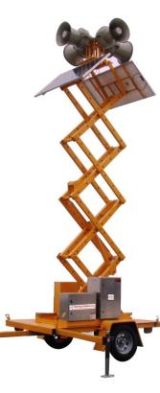
Alerting Solutions originally began as a different company based out of Santa Cruz, CA, under the name Raytek Technologies, Inc. in late 1979, who were a dealer for HÖRMANN in the United States. Alonside selling the electronic ECL and mechanical E57 sirens, Raytek also experimented with designs of their own by 1983, creating things such as a rotational electronic siren. Raytek existed under HÖRMANN for many years, and interest was garnered from other companies such as Sentry Siren to produce electronic sirens for them. This ultimately fell through by the early 1990s, however. Raytek became an official subsidiary of HÖRMANN America around this time.
In 1994, Alerting Communicators of America (ACA) had gone bankrupt, and was also bought by HÖRMANN America. With both companies under the same ownership, HÖRMANN America acted as a sort of dealership for the newly-branded American Signal Corporation (ASC), reselling several of ASC's and HÖRMANN's existing sirens under new name and branding. HÖRMANN ultimately drove ASC into the ground, with ASC being bought back by Dale Moeller in 1998, leading to ASC becoming its own independent company once again. ASI continued to deal HÖRMANN's sirens in the United States under the HÖRMANN America name until the late 2000s, when ASI broke off from HÖRMANN entirely and began producing sirens under their own name.
ASI continued to operate independently until 2013, when the company was bought by a company known as AtHoc Inc, which is a subsidiary of BlackBerry. The company fell on hard times over the next few years as sales plummeted from poor marketing, poor reliability and stiff competition, and in 2019, AtHoc filed to dissolve ASI, spelling the end for the company. Today, surviving ASI sirens are difficult to find, even less so in service, as most systems have been replaced entirely despite a relatively short service life. Raytek split off from HÖRMANN America in 2002, and currently exists today as a subsidiary of Fluke Process Instruments under the name Fluke-Raytek.
Products
ASI's sirens universally use Kingstar TU330/Taixing Minsheng Electronic fiberglass speakers, each containing 4 100 W speaker compression drivers. ASI's sirens can be told apart from similar sirens through the way they are mounted, as ASI's sirens often lack a frame to attach to and instead rely on the customer to install them onto an existing pole, which leads to some very unique setups. ASI lacked a controller of their own, originally relying on HÖRMANN (ASC) or Federal Signal MCP/UltraVoice electronic siren controllers. ASI's sirens operated on 24 V DC as standard, equipped with batteries and/or an optional solar panel which allows the siren to run up to 30 minutes after grid power is lost.
Stationary Electronic Sirens
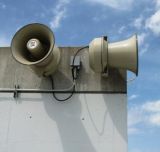
HA400SPKR
Advertised as the "building block" of all of ASI's sirens, the HA400SPKR is little more than a Kingstar speaker shell with ASI's branding on the cone. These speakers were sold independently of ASI's other sirens, which could allow for additional speakers to be added to an existing speaker station without needing to buy an entire new siren if more output was required. The HA400SPKR contains 4 100 W speaker compression drivers of unknown manufacture, and can be mounted independently just about anywhere through the contained mounting bracket, which has a swivel which allows the speaker to be aimed vertically where needed. These sirens were advertised as being useful for campus use, mounted on rooftops or walls. These are similar in purpose and function to a WS400H, Quadren, or DSA array. A single HA400SPKR unit can output up to 131 dB at point blank range.
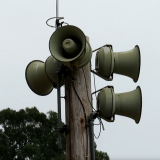
HA-416
The HA-416 is a directional 1600W electronic siren that is almost identical in appearance and function to an ATI HPSS-16 or E-Class EC8. The HA-416 consists of 4 HA400SPKR units attached to a common controller. The speakers do not come included with a frame, and instead this siren is designed to have the speakers mounted to an existing pole. Because of this, each HA-416 station is highly customizable, with either one speaker facing in each direction, or sacrificing output in one direction to boost output in another by having two speakers facing one direction. Each speaker contains 4 100 W speaker compression drivers for a total of 16 drivers, and the siren reaches 121 dB at 100 ft. A variant of the HA-416 exists called the HA-416D, which is a directional variant of the HA-416 which includes a rectangular metal mounting frame that allows multiple speakers to face one direction with ease. The HA-416D is otherwise entirely identical to an HA-416. Very few HA-416 units remain, with even fewer currently in service.
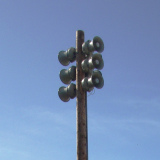
HA-624
The HA-624 is a rare omnidirectional 2400 W electronic siren that serves to bridge the gap between the HA-416 and HA-832. The HA-624 is a unique siren that makes use of 6 ASI HA400SPKR units attached to a common hexagonal frame, which could be mounted to the top of an existing pole. The frame is not required to mount the speakers, and as such the customer can choose a wide variety of configurations. One such installation was a bidirectional install with 3 speakers facing in each direction. The HA-624 has 6 speakers, each containing 4 100 W speaker compression drivers for a total of 24 drivers. The siren's decibel rating is unknown, and little else is known about this siren due to the fact that it is not listed on ASI's website, despite a picture of the siren being on the homepage. None of these sirens are known to survive.
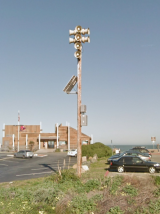
HA-832
The HA-832 is the most powerful omnidirectional siren offered by ASI, with twice as many speakers as the HA-416. The HA-832 consists of 8 ASI HA400SPKR units attached to a common controller, with mounting configuration being entirely customizable by the customer. The HA-832's speakers each contain 4 100 W speaker compression drivers, for a total of 32 drivers. The HA-832 reaches 127 dB at 100 ft. The HA-832 was available with an octagonal frame which could be attached to the top of a pole, which allowed the speakers to be mounted in an 8-way omnidirectional fashion. The HA-832 was not a success, with very few units being sold compared to the other models. Very few of these sirens are known to survive, with even fewer currently in service.
Rotational Electronic Sirens
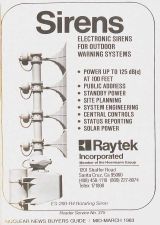
ES-200-R4
The ES-200-R4 was a unique rotational electronic siren that was produced by Raytek Technologies around 1983. It was the first siren produced by the company itself, rather than an existing HÖRMANN design, and had a high decibel rating of 125 dB at 100 ft, outperforming the then-new EOWS*812 and WS-3000. The siren's design is reminiscent of the WS-2000R, consisting of 4 HÖRMANN HLS-381 pneumatic siren horns with high power speaker compression drivers attached to the back of each horn, stacked vertically. Each horn is attached to the side of a cylindrical tube that contains the siren's wiring, leading to a small rounded box below the tube. The siren's presumably chain-driven rotator and collector rings are located in a teardrop-shaped housing below the siren. Unlike most rotational sirens, the ES-200-R4 is designed to be mounted to the side of a pole, rather than on top of one due to the rotator's unique shape. These sirens were purchased by a few nuclear power plants, but otherwise saw relatively few sales compared to its competition. It is unknown when this siren was discontinued, however it was likely when the company was reformed into HÖRMANN America.
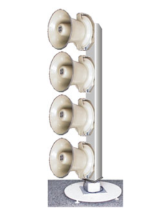
HA-416DR
The HA-416DR was a directional, rotational variant of the HA-416 that served as the replacement of the ES-200-R4. Like its predecessor, the HA-416DR consists of 4 speakers arranged vertically attached to a metal tube containing the wiring, spun by a rotator located underneath. The HA-416DR makes use of 4 HA400SPKR speakers, each containing 4 100 W speaker compression drivers for a total of 16 drivers. The siren was advertised as reaching 127 dB at 100 ft. The siren was rotated 360 degrees through a small rotator located underneath the siren, the design of which is unknown. Unfortunately, little else about this siren is known, as the only visual depiction of this siren from ASI is a photoshopped image. The lack of existing units, as well as the lack of photographic evidence of this siren's existence, suggests this siren never made it to production and only exists in ASI's catalogue.
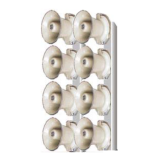
HA-832R
The HA-832R was a directional, rotational variant of the HA-832, and from what can be deciphered from the advertisement image, had a unique design. The HA-832R appears to be two HA-416DR units attached to a common rotator, in a similar fashion to the WS-4000-II. The HA-832R makes use of 8 HA400SPKR speakers, 4 per tube, each containing 4 100 W speaker compression drivers, for a total of 32 drivers. The siren was advertised as reaching 130 dB at 100 ft, and was rotated 360° by a rotator of unknown design underneath the siren. Unfortunately, little else about this siren is known, as the only visual depiction of this siren from ASI is a photoshopped image. The lack of existing units, as well as the lack of photographic evidence of this siren's existence, suggests this siren never made it to production and only exists in ASI's catalogue.
